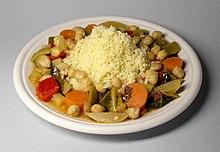
Back Cuina sefardita Catalan Kuchyně sefardských Židů Czech Gastronomía sefardí Spanish המטבח היהודי ספרדי HE Hidangan Yahudi Sefardim ID Olahan Yahudi Sepharadik JV


Sephardic Jewish cuisine is an assortment of cooking traditions that developed among the Sephardi Jews.
Those of this Iberian origin who were dispersed in the Sephardic Diaspora ultimately became the Eastern Sephardim and North African Sephardim as they settled throughout the Mediterranean in Turkey, Greece, the Balkans, and the Arab countries of West Asia and North Africa.[2]
Cuisine of the Sephardi Jews also includes the cuisine of those who became the Western Sephardim who settled in Holland, England, and from these places elsewhere.
Mizrahi Jews, being the pre-existing Jews of the Greater Middle East (of non-Spanish and non-Portuguese origin), are sometimes called Sephardim in a broader sense due to their style of liturgy. Although there is some overlap in populations due to the Sephardic Diaspora, Sephardic Jews also settled in many other countries outside the Greater Middle East as well.
As such, this article deals only with the cuisine of the Jewish populations with ancestral origins in the Iberian Peninsula, in whichever regions they settled, not just the Greater Middle East. For Cuisine of the Mizrahi Jews, please see that article.
As with other Jewish ethnic divisions composing the Jewish Diaspora, Sephardim cooked foods that were popular in their countries of residence, adapting them to Jewish religious dietary requirements, kashrut. Their choice of foods was also determined by economic factors, with many of the dishes based on inexpensive and readily available ingredients.
Animals deemed permissible as a source of meat had to be slaughtered in keeping with shechita, or Jewish ritual slaughter, which requires soaking and salting to remove blood. Hence, meat was often reserved for holidays and special occasions. Many Sephardi dishes use ground meat. Milk and meat products could not be mixed or served at the same meal.
Cooked, stuffed and baked vegetables are central to the cuisine, as are various kinds of beans, chickpeas, lentils, and bulgur/burghul (cracked wheat). Rice takes the place of potatoes.
- ^ Zhou, Weibiao (2014-06-04). Bakery Products Science and Technology. Wiley Blackwell. ISBN 9781118792070.
- ^ "Ashkenazi Jews Embrace Sephardic Fare - My Jewish Learning". myjewishlearning.com. Retrieved 23 March 2018.
© MMXXIII Rich X Search. We shall prevail. All rights reserved. Rich X Search